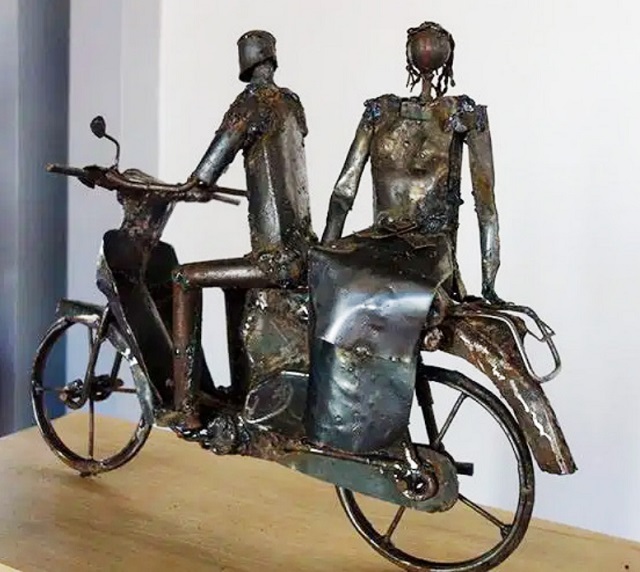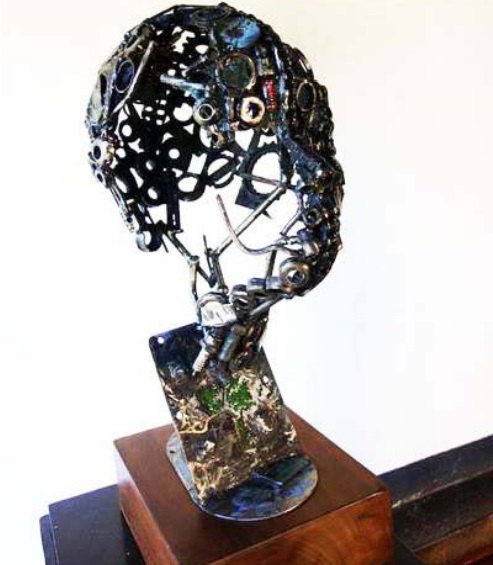
An exhibition by Makerere Art School Alumni
Kampala, Uganda | DOMINIC MUWANGUZI | It is exactly six years now that three fresh graduates of Margaret Trowell School of Industrial and Fineart got together to mount a show at the Makerere Art gallery. The three artists namely: Patrick Mulondo, Emmanuel Lwanga and Ivan Bwambale birthed the idea of annual exhibit Beautiful Imperfections that would interrogate the concept of experimental sculpture while dealing with everyday subjects of social significance to the community they lived in. In this regard, the particular initial showcase of sculptures produced from found objects, was intended to reflect the paradoxical experiences of social life and the beauty that underlies the human figure. Suffice to say, the three alumni of the oldest art school in East Africa, had earlier established their niches in exploring the human figure as a gesture to their studio prowess.
 Looking back on the technical competence of these then burgeoning artists; reflected through the exploration of form and depth using everyday objects like clay, aluminum plates and bolts, nuts and plugs obtained in neighbourhood nearest to them; one cannot help but ask how these “prodigies” could have easily mustered such innovativeness at an early stage of their careers. In the curatorial note that introduced the exhibition, Associate Prof. George Kyeyune invoked the name of Prof. Francis Xavier Nnagenda as the pioneer of experimental sculpture in Uganda and one who influenced senior lecturers like Dr. Rose Kirumira and Dr. Lilian Nabulime. He went on to describe some of the artworks on display as “archetypical figures and expressions of feminine beauty” within the context of how traditionally human figures either from hardwood or clay were a symbol of spiritualism and festivity. Such allusion insinuated the high caliber of craftsmanship the youthful artists had arrived at and was permeable through out the exhibition. Emmanuel Lwanga’s terracotta busts sometimes immersed in an introspective mood suggested the character of the African woman as a honest, serene and warm individual; yet in Bwambale’s series of Boda Boda welded from aluminum plates, the necessity of this mobile motorcycle taxi in everyday life was carefully captured.
Looking back on the technical competence of these then burgeoning artists; reflected through the exploration of form and depth using everyday objects like clay, aluminum plates and bolts, nuts and plugs obtained in neighbourhood nearest to them; one cannot help but ask how these “prodigies” could have easily mustered such innovativeness at an early stage of their careers. In the curatorial note that introduced the exhibition, Associate Prof. George Kyeyune invoked the name of Prof. Francis Xavier Nnagenda as the pioneer of experimental sculpture in Uganda and one who influenced senior lecturers like Dr. Rose Kirumira and Dr. Lilian Nabulime. He went on to describe some of the artworks on display as “archetypical figures and expressions of feminine beauty” within the context of how traditionally human figures either from hardwood or clay were a symbol of spiritualism and festivity. Such allusion insinuated the high caliber of craftsmanship the youthful artists had arrived at and was permeable through out the exhibition. Emmanuel Lwanga’s terracotta busts sometimes immersed in an introspective mood suggested the character of the African woman as a honest, serene and warm individual; yet in Bwambale’s series of Boda Boda welded from aluminum plates, the necessity of this mobile motorcycle taxi in everyday life was carefully captured.
The technical agility of the trio withstanding, the exhibit was intent to raise debate on how the art school can always play a pivotal role in the art careers of its graduates. Unlike the common belief that after graduation, students should forge their own art careers and be independent of the influence of their art teachers, it is important to maintain such critical connection or rather exchanges for possible assessment of a vibrant art career in the long-run. More so, such connection is a podium on which the now established artists can inspire the student artists, therefore creating confidence in them to create art that is both innovative and relevant to the immediate surroundings. This idea re- echoes the model of Margaret Trowell, founder of the Art School. She frequently organized exhibitions for her graduates as symbol of motivation for the other art students. Gregory Maloba, Sam Ntiro and Elimo Njau are some of the students who exhibited their art to their contemporaries.
 While the first edition was successful in it’s showcase of technical competence, studio innovation and motivation of art students to create relevant art, the exhibition did unluckily fail to keep its promise of being an annual event. There has not been subsequent editions of the show for the last six years. Unfortunately, there has never been any explanation to why such a brilliant idea like Beautiful Imperfect fizzled out only on its first outing. But even with such disturbing silence, it is quite possible that the exhibit failed because it was not primarily commercial. The irony of producing experimental art- a genre which art critics interpret as vital- is that it is not necessarily for sale ,but to raise conversations on critical issues affecting society. But organizing art exhibitions anywhere- including at a public gallery like Makerere Art gallery-requires money. In this regard, the public facility should have a budget to organize such event periodically. Was the exhibition funded by the institution or individual artists? This may be difficult to establish, but what is critical here is that an oldest institution like Margaret Trowell School of Industrial and Fineart should have a culture of sustainability. It is unfathomable that the audience was left guessing what next with an exhibition that fostered valuable exchanges between artists, art and public.
While the first edition was successful in it’s showcase of technical competence, studio innovation and motivation of art students to create relevant art, the exhibition did unluckily fail to keep its promise of being an annual event. There has not been subsequent editions of the show for the last six years. Unfortunately, there has never been any explanation to why such a brilliant idea like Beautiful Imperfect fizzled out only on its first outing. But even with such disturbing silence, it is quite possible that the exhibit failed because it was not primarily commercial. The irony of producing experimental art- a genre which art critics interpret as vital- is that it is not necessarily for sale ,but to raise conversations on critical issues affecting society. But organizing art exhibitions anywhere- including at a public gallery like Makerere Art gallery-requires money. In this regard, the public facility should have a budget to organize such event periodically. Was the exhibition funded by the institution or individual artists? This may be difficult to establish, but what is critical here is that an oldest institution like Margaret Trowell School of Industrial and Fineart should have a culture of sustainability. It is unfathomable that the audience was left guessing what next with an exhibition that fostered valuable exchanges between artists, art and public.
****
Images courtesy of Startjournal.org
The post Retrospect on Beautiful Imperfections appeared first on The Independent Uganda:.
from The Independent Uganda: https://ift.tt/3foEsLf
0 Comments